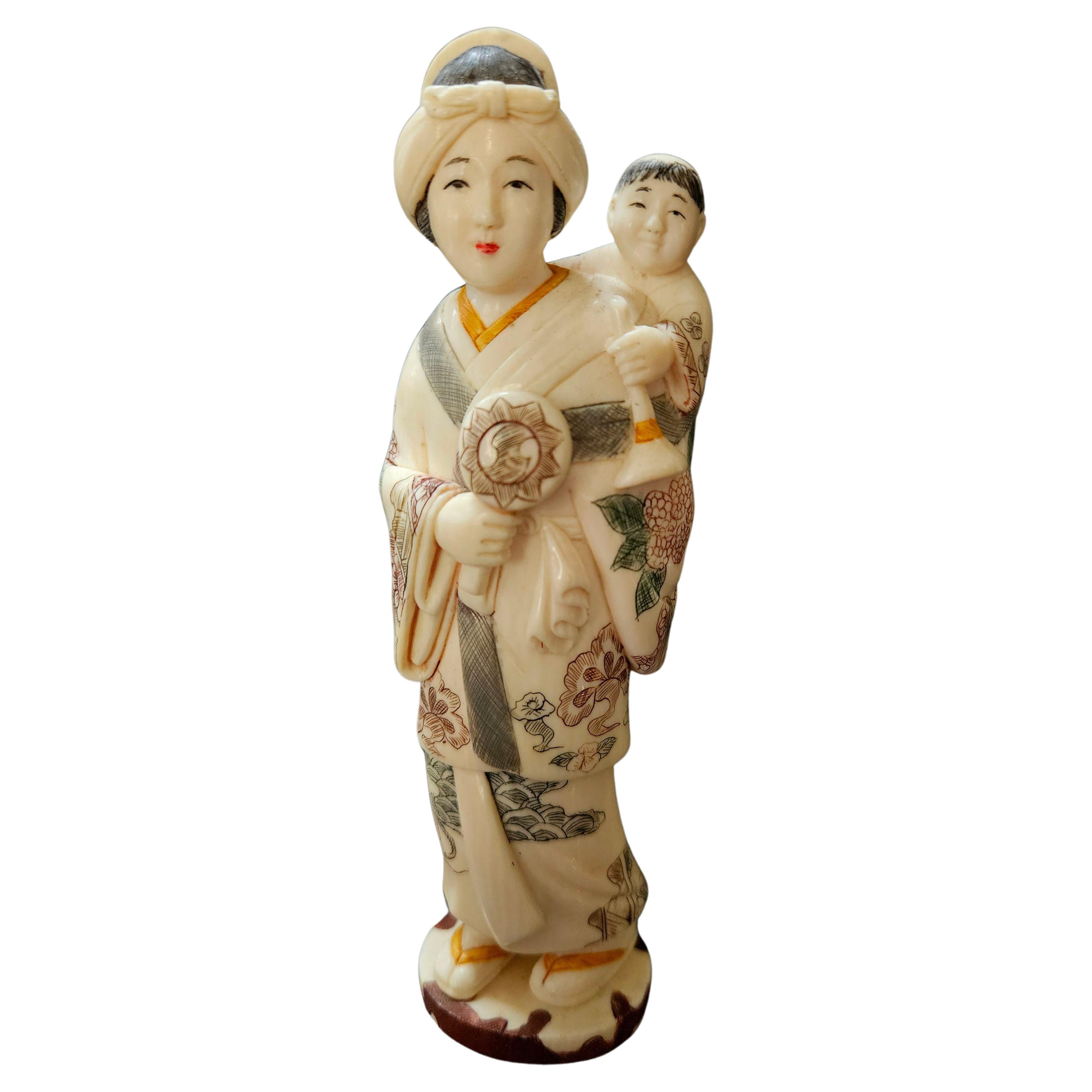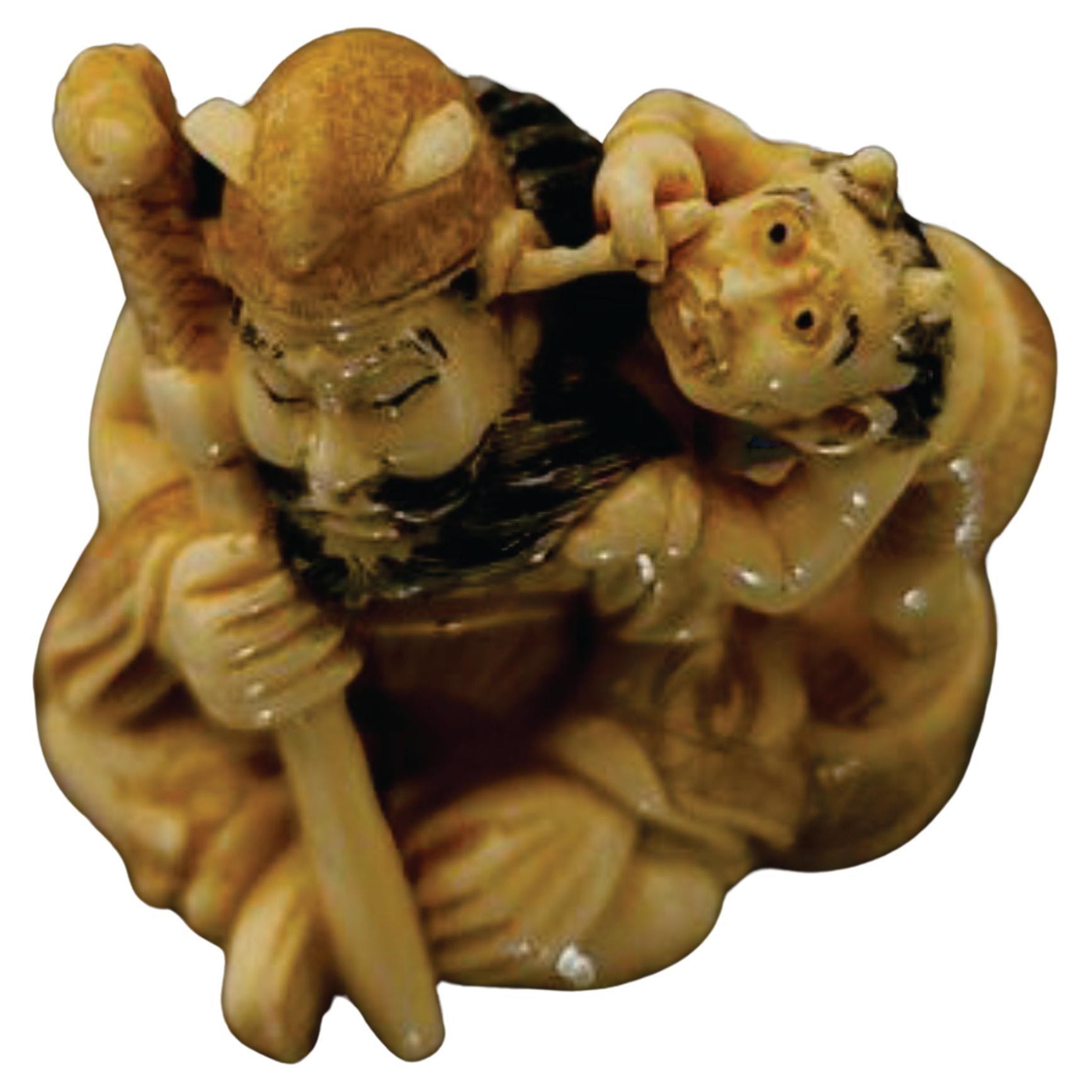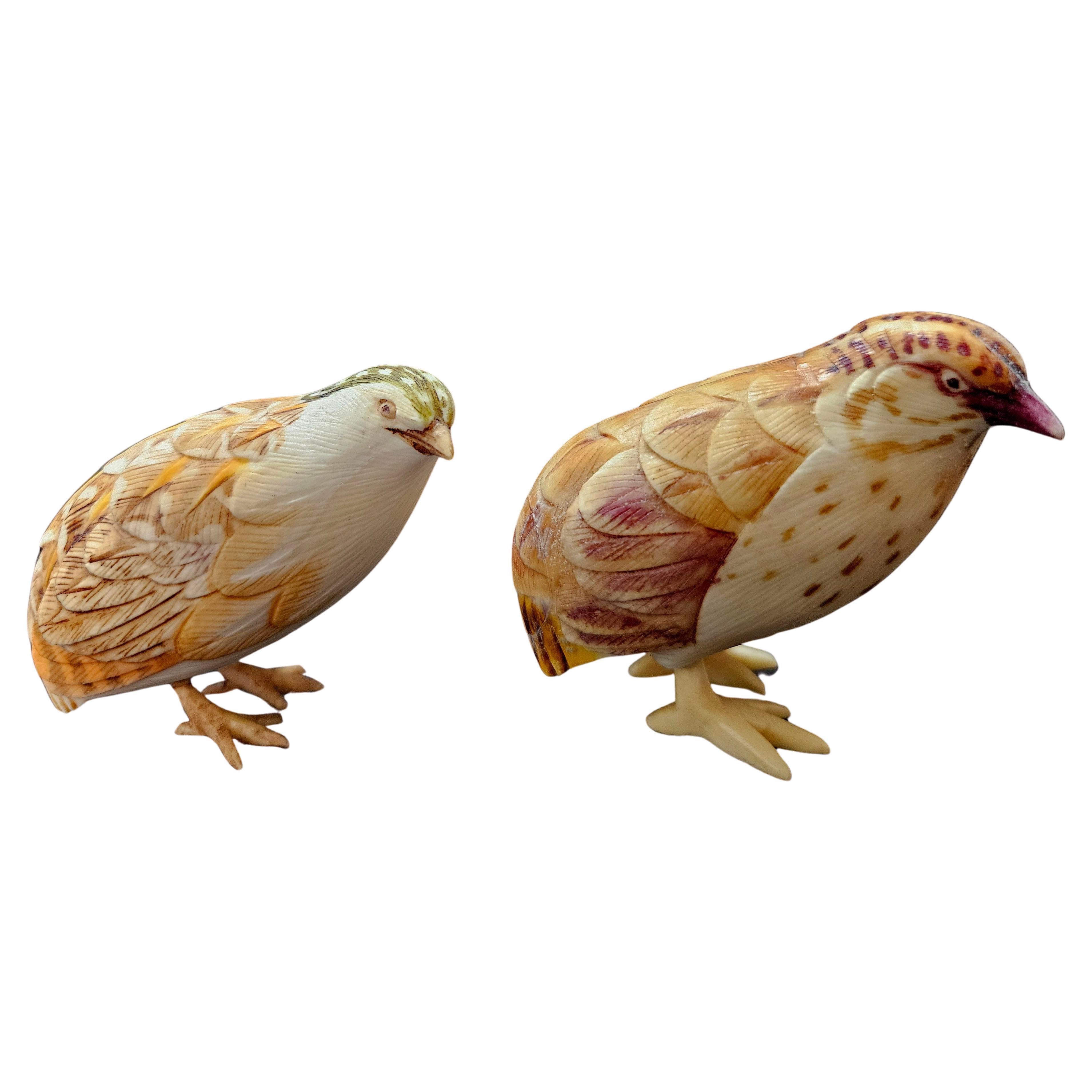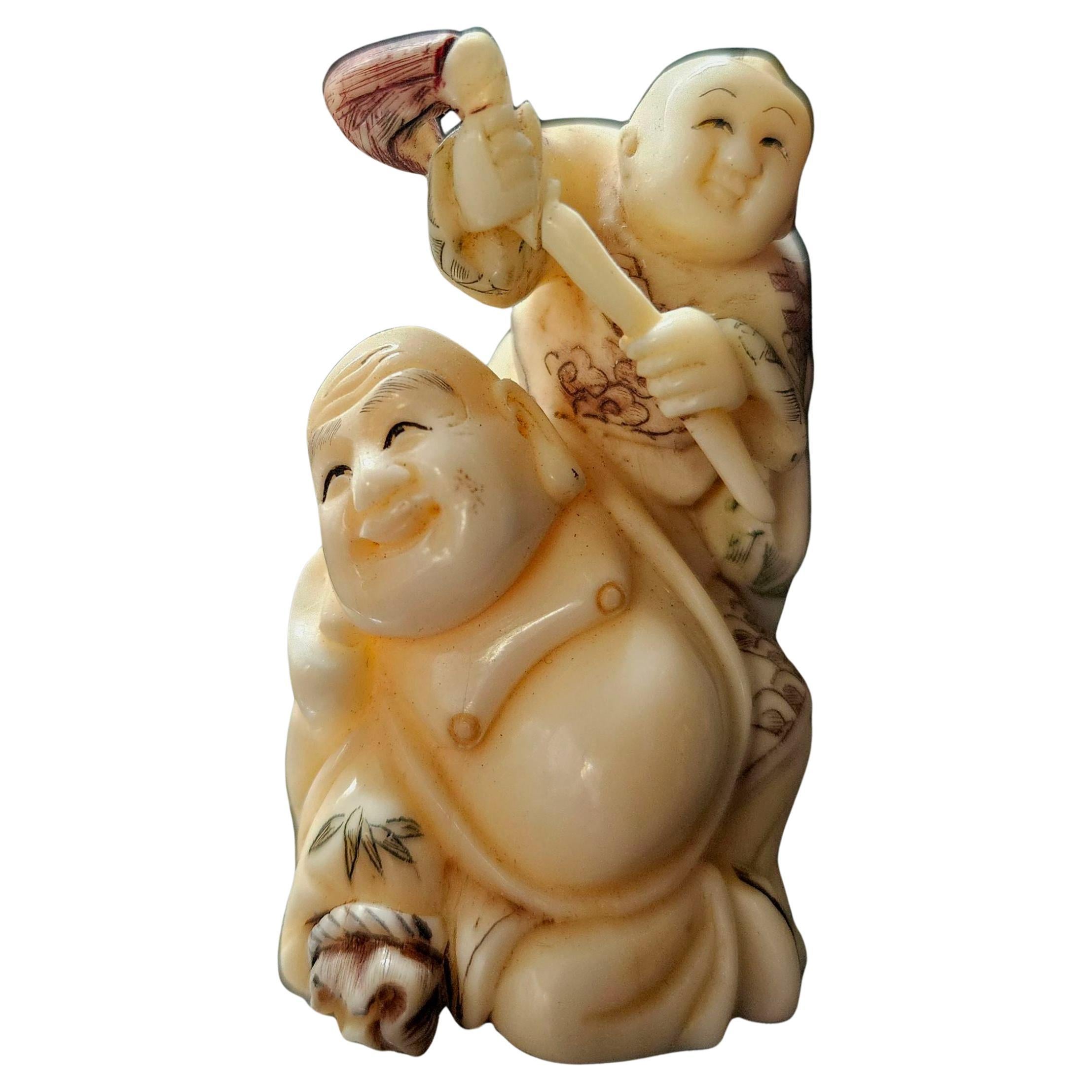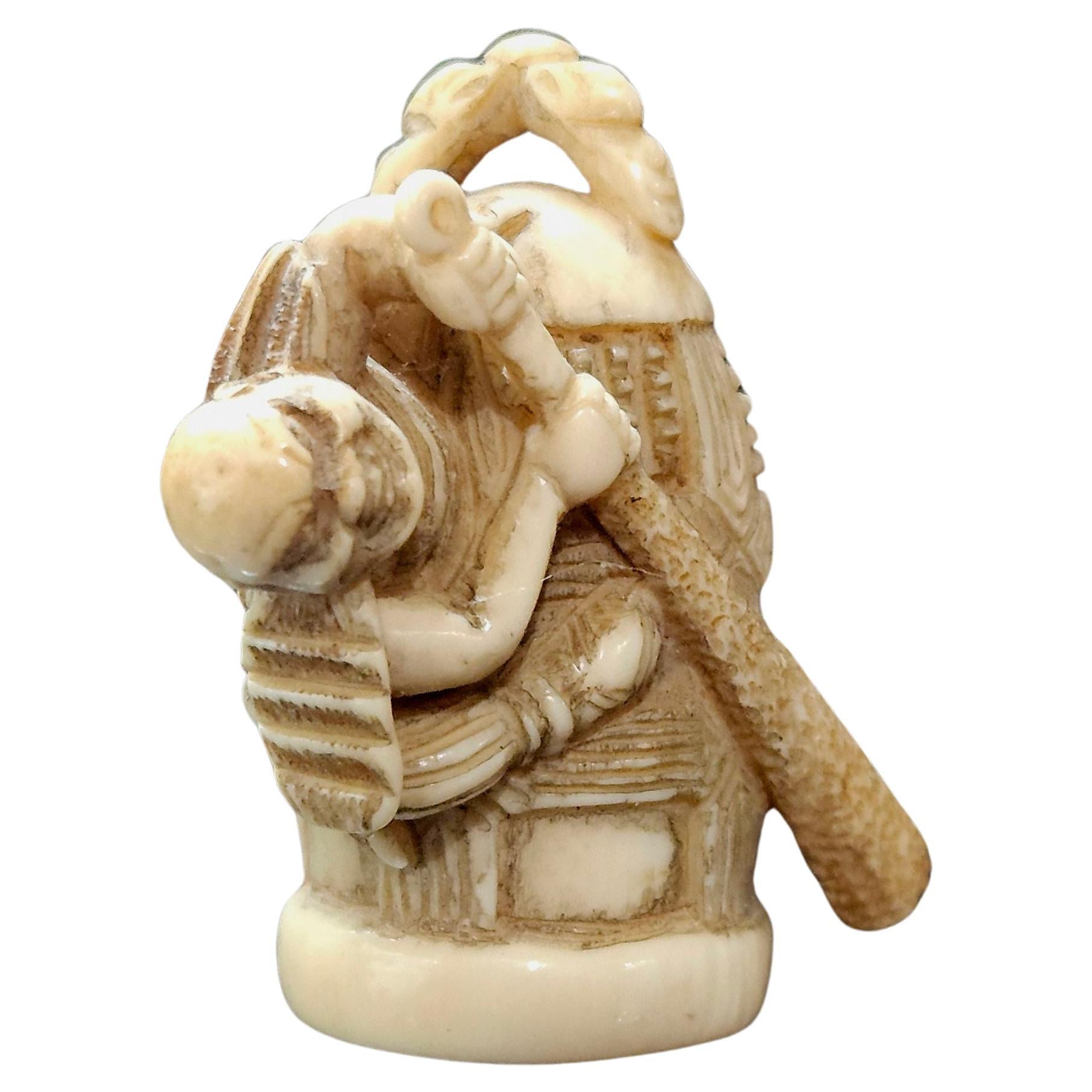Items Similar to Antique Japanese Carved Okimono Polychrome Decorated Group by Gyokko Meiji
Video Loading
Want more images or videos?
Request additional images or videos from the seller
1 of 19
Antique Japanese Carved Okimono Polychrome Decorated Group by Gyokko Meiji
About the Item
Antique Japanese Carved Okimono Polychrome Decorated Figure Group seated on a wood stand, signed by Gyokko, depicting a seated artisan carving and decorating a figure of a happy Buddha, having tea-stained accents and signed to the underside, raised on a hardwood base. Meiji Period.
Height: 3 1/4"
Width: 2.5"
Depth: 2"
Wood Stand: 3.25" Dia x 1" H
Shipping Note: USA only, no International shipping
- Dimensions:Height: 3.25 in (8.26 cm)Width: 2.5 in (6.35 cm)Depth: 2 in (5.08 cm)
- Materials and Techniques:
- Place of Origin:
- Period:
- Date of Manufacture:19th Century
- Condition:Wear consistent with age and use. Wear consistent with age and use.
- Seller Location:Norton, MA
- Reference Number:1stDibs: LU5848239615462
About the Seller
5.0
Platinum Seller
These expertly vetted sellers are 1stDibs' most experienced sellers and are rated highest by our customers.
Established in 2000
1stDibs seller since 2021
88 sales on 1stDibs
Typical response time: 1 hour
- ShippingRetrieving quote...Ships From: Norton, MA
- Return PolicyA return for this item may be initiated within 3 days of delivery.
More From This SellerView All
- Antique Japanese Carved Okimono Polychrome Decorated Group Mother & Son, MeijiLocated in Norton, MAAntique Japanese Carved Okimono Polychrome Decorated Figure Group Mother & Son, Meiji Period This item is 2" wide x1 5/8" deep x 6" high in dimension, from the late 19th century, a...Category
Antique 19th Century Japanese Decorative Boxes
MaterialsIvory, Paint
- Japanese Carved Netsuke Polychrome Decorated Figure Group by Tomoaki, MeijiLocated in Norton, MAJapanese Carved Netsuke Polychrome Decorated Figure Group, Signed by Tomoaki, Meiji period. Ric.NA005 A truly hand-carved ivory figure group, depicting a ghostbuster holding a sword...Category
Antique 19th Century Japanese Decorative Boxes
MaterialsIvory, Paint
- Japanese Carved Okimono Polychrome Birds by Tenzan (天山), Meiji PeriodLocated in Norton, MAJapanese Carved Okimono Polychrome Birds, Signed by Tenzan (天山) on the bottom, Meiji Period. A truly hand-carved ivory figure with fine craftsmanship in a detailed carving Dimension...Category
Antique 19th Century Japanese Decorative Boxes
MaterialsIvory, Paint
- Japanese Carved Netsuke Polychrome Figure Group #2 by Yoshikawa , MeijiLocated in Norton, MANetsuke Japanese Hand-Carved Polychrome Figure Group #2 by Yoshikawa "The Happy Buddha and a Kid" #H1, Signed on the bottom from the Meiji period. A truly hand-carved ivory figure wi...Category
Antique 19th Century Japanese Decorative Boxes
MaterialsIvory, Paint
- Japanese Carved Netsuke Polychrome Figure Group #1 by Yoshikawa , MeijiLocated in Norton, MANetsuke Japanese Hand-Carved Polychrome Figure Group #1 by Yoshikawa "The Happy Buddha and a Kid" #H1, Signed on the bottom from the Meiji period. A truly hand-carved ivory figure wi...Category
Antique 19th Century Japanese Decorative Boxes
MaterialsIvory, Paint
- Japanese Carved Netsuke Polychrome Figure Group by Gyokuseki (玉石) , MeijiLocated in Norton, MANetsuke Japanese Hand-Carved Polychrome Figure Group depicts a man holding a large cudgel and twining around a big bell, Signed by Gyokuseki (玉石) on the bottom from the Meiji Period. A truly hand-carved ivory figure with fine craftsmanship in a detailed carving This item is 1" wide x1" deep x 1.5" high in dimension, from the 19th century. This item is in excellent condition with no damages. Shipping Note: USA only, no International shipping The Essence of Netsuke: Like all art objects of great worth, netsuke distills the essence of a specific time and place. Worn as part of a traditional Japanese man’s ensemble from the 17th century onwards, the netsuke’s purpose was hyper-specific, and its functional simplicity lent artists unlimited freedom to constantly redefine what it could be. Formally, netsukes have few requirements: they must be small, they must have holes through which to pass a single cord, and they must have no protuberances that could damage one’s kimono. Everything else is left to the carver’s imagination. As such netsuke differs in style, subject, and material as widely as the personalities of their makers, and they are consequently supremely collectible. Netsuke emerged as a practical solution to dressing in 17th-century Japan. ‘Men’s kimonos didn’t have sewn-up sleeves — they were completely open, front and back, and that meant that the sleeves couldn’t be used as a pocket, as they could in women’s kimonos,’ Goodall explains. To carry things such as tobacco, medicine, or other necessities, men hung stylish inro and other vessels from cords looped under and behind the wide sashes that held their kimonos in place. At the other end of those cords, men fastened small, ornamental objects as counterweights; those objects evolved into netsuke. The netsuke’s origins are still ‘theoretical’, Goodall says. ‘It’s thought that, with increasing imports from China in the late 17th and early 18th centuries, the toggles that were used on Chinese clothing...Category
Antique 19th Century Japanese Decorative Boxes
MaterialsIvory, Paint
You May Also Like
- Japanese Meiji Bronze Okimono of a Wild Boar by Akasofu GyokkoLocated in Shippensburg, PAOKIMONO OF A WILD BOAR Japan, Meiji Period Patinated bronze over carved hardwood base Signed "Gyokko" to underside of boar Item # 301COR20S This remarkable sculpture was designe...Category
Antique 19th Century Japanese Meiji Animal Sculptures
MaterialsBronze
- Japanese Laquered Tray Decorated with People on a Verandah, Meiji PeriodLocated in Lincoln, LincolnshireThis is a good papier mâché, circular, black lacquered tray, hand enameled and gilded, made in Japan during the 19th century, Meiji period. This circular tray is very decorative, ...Category
Antique 19th Century Japanese Meiji Lacquer
MaterialsPaper
- Japanese Meiji Period Carved Large Turtle OkimonoLocated in New York, NYA Japanese Meiji Period late 19th, early 20th century carved boxwood turtle okimonoCategory
20th Century Japanese Sculptures
MaterialsBoxwood
- Antique Japanese Meiji Period Lacquered Box w/ Original CaseLocated in New York, NYA wooden lacquered box with gold details dating from Japan's Meiji period. The piece comes complete with its original outer storage box. 9822Category
20th Century Japanese Boxes
MaterialsWood
- Antique Japanese Cloisonné Meiji Enamel Box with RoostersLocated in New York, NYAn antique Japanese Meiji era covered enamel over brass trinket or jewelry box. Circa: late 19th century to early 20th century. The ware is enameled with a polychrome image of a roos...Category
Early 20th Century Japanese Meiji Decorative Boxes
MaterialsBrass, Enamel
- Antique Student Pencil Box Japanese Lacquer Ware Writing Meiji Period JapanLocated in Amsterdam, Noord HollandA Japanese lacquer writing box 19th Century Of rectangular shape, overall painted in gold with a faboulas landscape scene on a brown lacquer ground, the interior in black. Additiona...Category
Antique 19th Century Japanese Decorative Boxes
MaterialsLacquer
Recently Viewed
View AllMore Ways To Browse
Antique Notes
Antique Polychrome
Group 1
Ivory Carved
Hand Carved Ivory
Ivory Japan
Japanese Ivory
Boxes Meiji Japan
Box Japanese Meiji
Carved Antique Ivory
Carved Ivory Antique
Hand Painted Japanese Box
19th Century Japanese Figure
Carved Polychrome Figure
Japanese Meiji Period Box
Antique Box Seat
Antique Wood Painted Boxes
19th Figural Box
